 , 崔阳2, 潘月鹏2, 田世丽2, 李广1
, 崔阳2, 潘月鹏2, 田世丽2, 李广1
 , 倪雪2, 黄威2, 刘博文2, 顾梦娜2, 吕雪梅2, 何月欣2, 王跃思1,2
, 倪雪2, 黄威2, 刘博文2, 顾梦娜2, 吕雪梅2, 何月欣2, 王跃思1,2

1. 甘肃农业大学林学院, 兰州 730070;
2. 中国科学院大气物理研究所, 大气边界层物理和大气化学国家重点实验室, 北京 100029
收稿日期: 2019-03-12; 修回日期: 2019-04-15; 录用日期: 2019-04-15
基金项目: 国家重点研发计划项目(No.2016YFD0800302,2017YFC0210100)
作者简介: 张国忠(1987-), 男, E-mail:zhangguozhong@dq.cern.ac.cn
通讯作者(责任作者): 李广, E-mail:wys@dq.cern.ac.cn
王跃思, E-mail:lig@gsau.edu.cn
摘要: 干湿沉降是污染物从大气进入到地表生态环境的主要途径.渤海湾临近大气污染严重的京津冀地区,同时受航运交通排放影响,但渤海湾大气金属元素沉降量及其来源并不十分清楚.本研究于2016年11月—2017年10月在渤海西岸采集了大气沉降样品,利用电感耦合等离子体质谱仪(ICP-MS)对样品中25种金属元素的含量进行了测定分析,估算了大气金属沉降量并进行了源解析.结果表明:沉降样品中25种元素的浓度变化范围为2458.8 μg·L-1(Ca)~9.9 ng·L-1(Th),年沉降量变化为1229.9 mg·m-2·a-1(Ca)~5.0 μg·m-2·a-1(Th).受降水量季节分布的影响,多数金属元素的沉降量在夏季最高,春秋季较低.除Be、Fe、Ni、Cr、Al、Th和U等元素外,其余18种元素都有不同程度的富集,特别是Cd、Ag、Se和Sb等元素已高度富集.燃煤(12.8%)、扬尘(25.9%)、工业(33.1%)和航运(28.2%)是渤海湾沉降样品中金属元素的主要来源,尤其是航运排放对海湾大气Sb、Cd和Mo沉降具有显著贡献.研究结果可为京津冀区域海陆协同发展和环境质量改善提供科学参考.
关键词:大气沉降金属元素沉降通量来源解析渤海湾
Deposition fluxes and source apportionment of atmospheric trace metals in the Bohai Bay
ZHANG Guozhong1,2
 , CUI Yang2, PAN Yuepeng2, TIAN Shili2, LI Guang1
, CUI Yang2, PAN Yuepeng2, TIAN Shili2, LI Guang1
 , NI Xue2, HUANG Wei2, LIU Bowen2, GU Mengna2, Lü Xuemei2, HE Yuexin2, WANG Yuesi1,2
, NI Xue2, HUANG Wei2, LIU Bowen2, GU Mengna2, Lü Xuemei2, HE Yuexin2, WANG Yuesi1,2

1. College of Forestry, Gansu Agricultural University, Lanzhou 730070;
2. State Key Laboratory of Atmospheric Boundary Layer Physics and Atmospheric Chemistry, Institute of Atmospheric Physics, Chinese Academy of Sciences, Beijing 100029
Received 12 March 2019; received in revised from 15 April 2019; accepted 15 April 2019
Abstract: Dry and wet deposition is the main way for pollutants to enter the surface ecological environment from the atmosphere. The Bohai Bay is close to the Beijing-Tianjin-Hebei region, where air pollution is serious, and is also affected by shipping sources. However, the atmospheric metals deposition fluxes and their sources in the Bohai Bay are indistinct. Bulk rain samples were collected in the West coast of the Bohai sea between November 2016 and October 2017. The concentrations of 25 trace metals in the samples were analyzed by inductively coupled plasma mass spectrometer (ICP-MS). The results show that the concentrations of metals in samples varied from 2458.8 μg·L-1(Ca) to 9.9 ng·L-1(Th). Fluxes of metals varied from 1229.9 mg·m-2·a-1 (Ca) to 5.0 μg·m-2·a-1 (Th). Due to the seasonal distribution of precipitation, most metal deposition fluxes are highest in summer and lower in spring and autumn. Except Be, Fe, Ni, Cr, Al, Th and U, the other 18 metals are enriched in varying degrees, especially Cd, Ag, Se and Sb show high enrichment. Coal (12.8%), dust (25.9%), industry (33.1%) and shipping (28.2%) were the main sources of trace metals in the deposition samples of the Bohai Bay. Shipping emissions have an important influence on the atmospheric deposition of Sb, Cd and Mo. The research results can provide scientific reference for the coordinated development of land and sea in Beijing-Tianjin-Hebei region and the improvement of environmental quality.
Keywords: atmospheric depositiontrace metalsdeposition fluxsource apportionmentBohai Bay
1 引言(Introduction)大气沉降是地表生态环境中金属元素的主要来源之一(Theodosi et al., 2013).海岸区域重金属元素有20%~70%来自大气沉降(Deboudt et al., 2004).大气重金属沉降会对生态系统产生不同程度的生态毒性影响(仇帅等, 2015).这种生态毒性影响可通过食物链不断富集, 最终危害人体健康(Cizmecioglu et al., 2008; 李莲芳等, 2007).因此, 大气沉降中的金属元素的来源备受关注(Theodosi et al., 2010; Montoya-Mayor et al., 2013).
大气沉降中元素的浓度和通量受多种因素影响, 包括降雨量、本地排放和区域传输等(Kim et al., 2012).这些金属元素来源复杂, 沉降样品各元素是多种自然源和人为源的混合.为解析大气沉降中金属元素的来源, 以往的研究采用了诸如富集因子(EF)分析(Fernández-Olmo et al., 2014)、正交矩阵因子分解(PMF)(Desboeufs et al., 2018)、潜在源贡献因子(PSCF)分析(Wang et al., 2009)等.这些方法各有优缺点, 结合在一起使用可以更好的了解金属的来源.
渤海湾是我国渤海区域的第二大海湾, 约占渤海总面积的1/5.渤海湾三面环陆, 与工业区天津的陆岸相邻, 西部塘沽是重要港口.周边密集的工业和航运等人类活动对海域生态环境产生了严重影响(张雷等, 2011; 秦延文等, 2012).本文通过在该区域为期一年的沉降观测实验, 旨在分析渤海湾大气沉降中的金属元素浓度和沉降通量, 解析大气沉降中金属元素的主要来源.研究结果可以为海湾大气环境和生态保护提供有益参考.
2 材料与方法(Materials and methods)2.1 采样方法采样点位于天津市滨海新区气象观测场内(39°3′N, 117°43′E).用聚甲基丙烯酸甲酯材料的雨量桶(直径20 cm, 高1.5 m)收集每日降水.用量筒准确量取降水总体积后, 将样品分装到2个50 mL的PET小瓶冷冻保存.每次样品采集后, 用去离子水(18.2 MΩ·cm)冲洗采样器, 以防止残留对下次样品产生影响.在2016年11月—2017年10月观测期内共收集样品35个, 采样期信息和降水量统计信息如图 1所示.
图 1(Fig. 1)
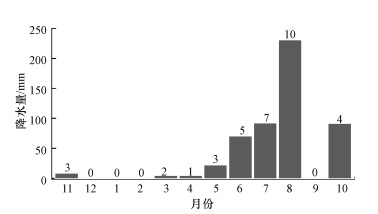 |
| 图 1 采样信息和降水量统计图(柱状图上数字表示本月降水次数) Fig. 1Sampling information and precipitation statistics |
2.2 分析方法2.2.1 样品运输与前处理样品采集后在3个月内用保温箱寄送至大气边界层物理和大气化学国家重点实验室.取解冻后的样品20 mL加入硝酸(sigma-aldrich, 德国)调节pH值至约等于1, 静置24 h待测.
2.2.2 样品分析采用电感耦合等离子体质谱仪(ICP-MS 7500ce, Agilent)分析样品中的Be(铍)、Na(钠)、Mg(镁)、Al(铝)、K(钾)、Ca(钙)、V(钒)、Cr(铬)、Mn(锰)、Fe(铁)、Co(钴)、Ni(镍)、Cu(铜)、Zn(锌)、As(砷)、Se(硒)、Mo(钼)、Cd(镉)、Sb(锑)、Ba(钡)、Tl(铊)、Pb(铅)、Th(钍)、U(铀)、Ag(银)等25种金属元素浓度.每个样品测试3次, 根据内标元素(45Sc(钪)、72Ge(锗)、115In(铟)、209Bi(铋)、Part #5188-6525, Agilent)的相对标准偏差(RSD)检查仪器的稳定性(要求内标元素RSD < 3%, 否则重新测试样品).实验分析过程质量控制和质量保障技术方法参考文献(Pan et al., 2015).
2.2.3 沉降通量计算由于绝大部分金属元素无气态相态, 主要以颗粒物的形式发生干沉降或被降水清除, 所以本研究采集到的混合沉降样品代表大气中金属元素的总沉降量(Omrani et al., 2017).估算公式如下:
 |
2.2.4 元素来源解析方法本研究中采用PMF 5.0(美国EPA)来解析沉降样品中元素的来源.PMF模型的原理是将样本数量和物种信息看做一个n×m的矩阵X(i, j), 矩阵X(i, j)被分解为源谱矩阵F和源贡献矩阵G.PMF解析模型的目标就是找p个污染源的成分谱矩阵F(k, j)p×m和p个污染源在每一个样本中的贡献矩阵G(i, k)n×p, k代表污染源.第ij个样本的实测质量浓度Xij可以表达为:
 |
2.2.5 潜在源贡献因子分析法潜在源贡献因子分析法(PSCF)是判断大气污染物潜在源区的一种统计方法(Ashbaugh et al., 1985).PSCF值是经过网格ij的污染轨迹数(mij)与该网格上经过的所有轨迹数(nij)的比值, 即PSCFij= mij/nij.PSCF的值越大表明该网格点对该污染物的浓度贡献越大.PSCF值所对应网格组成的区域就是影响该污染物浓度的潜在源区.由于PSCF是条件概率, 当nij较小时, PSCF计算结果的不确定性较大.此时, 可引入权重函数Wij(Hopke et al., 1995)来降低计算的不确定性, 即:WPSCF = Wij × PSCF.为确定沉降样品中元素的潜在源区, 本文选取特定元素进行PSCF分析, 基于TrajStat软件实现了数据处理和绘图分析(Wang et al., 2009).本文采用500 m高度的气团来向与轨迹变化进行分析, 追踪48 h气团后向轨迹.
3 结果和讨论(Results and discussion)3.1 渤海湾大气沉降中金属元素浓度特征图 2为观测期间降水量和沉降样品中元素浓度变化.可以看出, 每种元素的浓度变化有相似的时间演变趋势.进一步对降水量和沉降样品中元素浓度作统计分析(图 3), 发现两者呈显著负相关(-0.41 < r < -0.18, p < 0.05).这是因为较大的降水量对样品中的元素具有稀释作用, 而较小的降水量对样品中的元素有“浓缩”效应.除降水量外, 沉降样品中的元素浓度也受排放源强度的影响.从图 2也可以看出, 排放源较强的季节(11月—次年5月), 沉降样品中元素的浓度高于其他时段.另外, 沉降样品中绝大多数元素浓度的最高值出现在2017年3月22日.该次降水量较小(2.3 mm), 且处于排放源较强时段.除了这两个因素, 该次降水之前有3个多月未采集到有效样品, 采样器上可能累积了大量的气溶胶干沉降.对于不同气团轨迹样品的浓度规律将在本文3.4节进行详细讨论.
图 2(Fig. 2)
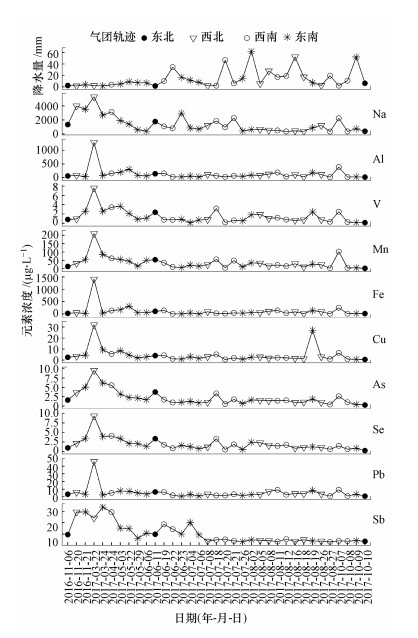 |
| 图 2 沉降样品中金属元素浓度和降水量(*表示p < 0.05) Fig. 2Variability for trace metals concentration and precipitation |
图 3(Fig. 3)
 |
| 图 3 沉降样品中元素浓度和降水量相关性分析(*表示p < 0.05) Fig. 3Correlation analysis of trace metals concentration and precipitation in deposition samples |
图 4为沉降样品中元素的浓度水平和变化范围.如图所示, 25种元素浓度(降水量加权平均浓度)大小次序为Ca> Na> Mg> K> Al> Fe> Zn> Mn> Ba> Sb> Pb> Cu> Se> As> V> Ni> Cr> Co> Cd> Mo> Ag> Tl> U> Be> Th.对同一元素而言, 不同降水事件中浓度变化范围均超过一个数量级, 这可能是降水量大小和元素来源不同所导致的.与国内外其它海湾地区相比, 渤海湾人为源的金属元素浓度处于较高水平.如表 1所示, 渤海湾沉降中金属元素浓度水平与胶州湾较为一致, 明显低于法国重工业港口勒阿弗尔.但大多数元素浓度高于美国特拉华湾和日本的4个滨海区域站点.这可能是由于污染源的排放强度和降水量不同所造成的.
图 4(Fig. 4)
 |
| 图 4 沉降样品中金属元素的浓度水平 Fig. 4The concentration level of trace metals in deposition samples |
表 1(Table 1)
| 表 1 渤海湾及其它海湾地区大气沉降金属元素浓度 Table 1 Concentration of trace metals in atmospheric deposition in Bohai Bay and other bay areas | ||||||||||||||||||||||||||||||||||||||||||||||||||||||||||||||||||||||||||||||||||||||||||||||||||||||||||||||
表 1 渤海湾及其它海湾地区大气沉降金属元素浓度 Table 1 Concentration of trace metals in atmospheric deposition in Bohai Bay and other bay areas
| ||||||||||||||||||||||||||||||||||||||||||||||||||||||||||||||||||||||||||||||||||||||||||||||||||||||||||||||
3.2 渤海湾沉降样品中金属元素富集特征为分析沉降样品中元素的污染程度, 以Al为参比计算了25种元素的富集因子(Duce et al., 1975), 公式如下:
 |
图 5为渤海湾沉降样品中元素的富集因子.可以看出, Be、Fe、Ni、Cr、Al、Th和U元素的EF < 10, 表明这些元素主要来自于自然源;Mn、Na、K、Mg、Mn、Cu、Co和Mo元素的EF介于10和100之间, 表现为中等富集;Ca、Tl、As、Pb、Zn、Ag、Sb和Se元素EF>100, 表现为高度富集.特别是Cd、Ag、Se和Sb这4种金属的EF>1000, 表明这些元素可能主要来自于人为源.
图 5(Fig. 5)
 |
| 图 5 沉降样品中金属元素属富集因子 Fig. 5Enrichment factors of trace metals in deposition samples |
3.3 渤海湾沉降样品金属元素来源解析运行PMF模型过程中, 发现Ag的模拟值和测量值相关性很低(< 0.1), 因此在后续分析剔除了该元素.共尝试了5组预实验, 选取2、3、4、5、6个因子分别运行了PMF模型.通过对比分析残差矩阵值、因子的可解释性和运行结果的不确定性等信息, 发现选取4个因子时的PMF运行结果最稳定, 进而解析得到图 6所示的源成分谱.
图 6(Fig. 6)
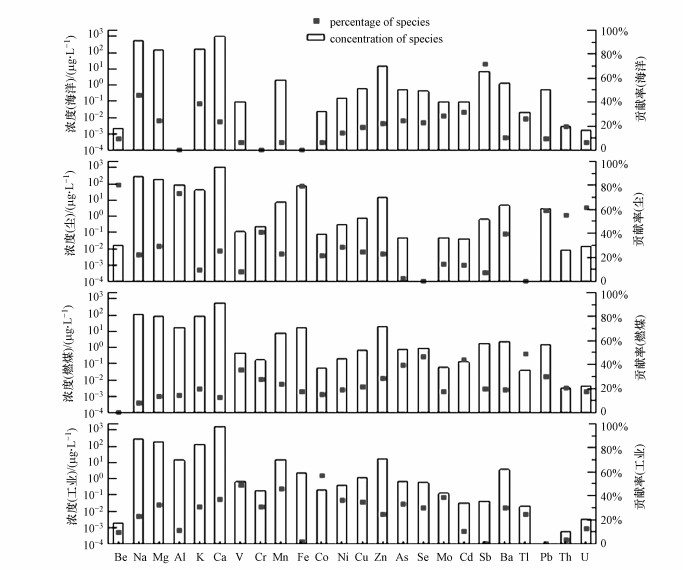 |
| 图 6 PMF源解析结果 Fig. 6PMF-derived profiles of the four sources |
图 6中的第一类因子为燃煤源, 由As、Se标识, 同时伴随高浓度的Cd和Tl.As和Se是燃煤的重要指示元素(Tian et al., 2015; 张丹龙等, 2016).渤海湾区域内钢铁工业生产和火力发电消耗煤炭的过程中会排放大量重金属.燃煤贡献了沉降样品中元素的12.8%.第二类因子为扬尘源, 由Al、Fe、Th、U、Be、Ba等元素标识, 这些元素主要为矿物元素(Desboeufs et al., 2018).此外, Pb、Cr等元素的浓度也相对较高, 表征道路扬尘再次进入大气沉降.扬尘贡献了沉降样品中元素的25.9%.第三类因子为工业源, 由V、Mn、Co标识, 同时伴随高浓度的Cr、Ni、Cu、Zn、Mo.这些元素通常作为工业生产和化石燃料燃烧的指示性元素(Yang et al., 2013).工业贡献了沉降样品中元素的33.1%.第四类因子为航运源, 由Sb、Cd、Mo、Na和Mg等元素标识.Na和Mg是海盐粒子的特征元素(韩斌等, 2010).航运所用的燃料主要为柴油, 燃烧过程中会产生大量Cd、Sb和Mo等元素(Wang et al., 2003).航运贡献了沉降样品中元素的28.2%.
3.4 后向轨迹聚类和潜在源区分析PMF源解析模型只能识别污染源的类型, 但不能确定主要污染源的方位.污染物从污染源进入大气后会随气团传输到排放源外的区域.因此, 气团的运动轨迹能够反映污染物的主要源区.通过气团轨迹聚类, 发现影响渤海湾的气团可分为东北、西北、西南以及经过海湾的东南气团4大类(图 7a).
图 7(Fig. 7)
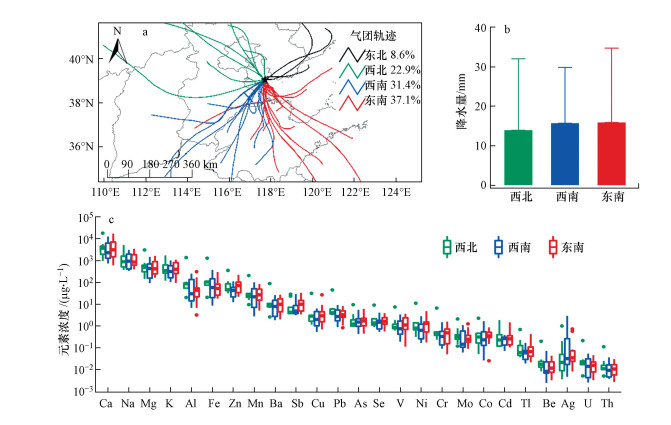 |
| 图 7 气团后向轨迹聚类及沉降样品金属元素浓度统计 Fig. 7Rainfall and trace metals concentrations under different air masses trajectories |
图 7c统计了各类气团的元素浓度特征(东北气团轨迹数量较少, 无统计学意义, 本文不讨论).可以看出, 西北气团样品中的大多数元素浓度普遍高于西南气团和东南气团, 特别是Fe、Al、Ba、Be、Pb、U和Th等元素.这可能是因为西北气团降水量相对较少(图 7b), 且西北气团往往伴随沙尘的传输.西南气团和东南气团降水量很接近(图 7b), 元素浓度的差异(图 7c)在一定程度上反映了源区排放量的差异.可以看出, Na、Mg、K、Zn、Sb、Cd、Ni和Mo等元素在东南气团沉降样品中的浓度高于西南气团.虽然这两类气团都经过河北和山东的工业区(图 7a), 但东南气团还经过了渤海湾的海域, 可能受到航运排放的影响.
为进一步确定样品中金属元素的潜在源区, 分别选择燃煤、扬尘、工业和航运源的指示元素Se、Fe、V和Sb进行PSCF分析, 结果如图 8所示.可以看出, Se元素(燃煤)的潜在源区主要分布在天津西南部、北京南部以及河北中部, 这些区域是燃煤消耗量较大的典型工业区.Fe元素(扬尘)的PSCF高值主要分布在距离观测点较近的区域和西北地区, 反映了局地扬尘和西北沙尘气团传输的贡献.作为工业源指示元素, V的潜在源区分布较广, 包括环渤海湾区域、河北中东部和山东西北部, 这和华北的工业区分布较为吻合.Sb元素(航运源)的PSCF高值集中分布在渤海海域及海岸沿线, 印证了海洋航运对近海陆地大气重金属污染的强烈影响.上述元素的主要的潜在源区与PMF解析得到的污染源类型具有很好的一致性, 研究结果相互支持, 进一步说明本研究源解析结果的可靠性.
图 8(Fig. 8)
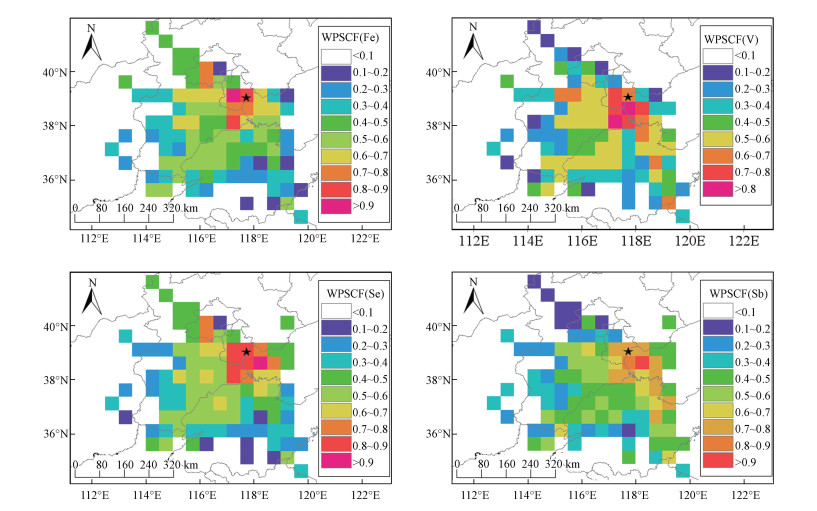 |
| 图 8 特征元素潜在源贡献因子分析 Fig. 8PSCF analysis of tracer elements |
3.5 渤海湾大气金属元素沉降通量图 9为沉降样品中25种金属元素沉降通量的季节变化特征(冬季未采集到有效降水).可以看出, 绝大多数元素在夏季的沉降通量高于春秋季.我国大亚湾(Wu et al., 2018)和德国(Gr?mping et al., 1997)的研究中也有类似发现.渤海湾属于温带季风性气候, 降水主要发生在夏季(夏季降水量为391.5 mm, 占全年降水量的78.3%).由于降水集中, 夏季大气金属的沉降通量占全年的62%~78%.
图 9(Fig. 9)
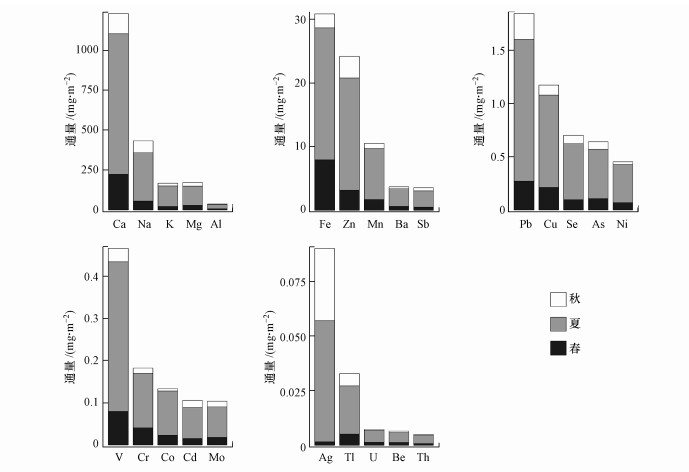 |
| 图 9 沉降样品中金属元素通量季节变化 Fig. 9Seasonal variations in atmospheric deposition fluxes of trace metals |
沉降样品中不同元素年沉降通量差异较大(图 9).25种元素年沉降通量的大小次序为Ca> Na> Mg> K> Al> Fe> Zn> Mn> Ba> Sb> Pb> Cu> Se> As> V> Ni> Cr> Co> Cd> Mo> Ag> Tl> U> Be> Th.与国内外其它海湾地区相比渤海湾主要人为源的金属元素沉降通量处于中等水平.如表 2所示, 渤海湾大多数金属元素沉降通量与其他海湾地区相当.但可能受到航运业的影响Sb元素沉降量明显高于其他海湾站点(Sakata et al., 2009).
表 2(Table 2)
| 表 2 渤海湾及其他海湾地区大气金属元素沉降通量 Table 2 Deposition flux of trace metals in Bohai Bay and other bay areas in China and worldwide | ||||||||||||||||||||||||||||||||||||||||||||||||||||||||||||||||||||||||||||||||||||||||||||||||||||||||||||||||||||||
表 2 渤海湾及其他海湾地区大气金属元素沉降通量 Table 2 Deposition flux of trace metals in Bohai Bay and other bay areas in China and worldwide
| ||||||||||||||||||||||||||||||||||||||||||||||||||||||||||||||||||||||||||||||||||||||||||||||||||||||||||||||||||||||
4 结论(Conclusions)1) 观测发现渤海湾大气沉降样品中25种元素的浓度范围为2458.8 μg·L-1 (Ca)~9.9 ng·L-1(Th), 各元素浓度变化范围超过一个量级.除Be、Fe、Ni、Cr、Al、Th和U等元素外, 其余元素都有不同程度的污染富集, 特别是Cd、Ag、Se和Sb等元素呈现严重富集.
2) 基于PMF模型, 解析出渤海湾沉降样品中元素的主要污染源为燃煤、扬尘、工业和航运源, 4种类型的源分别贡献了沉降样品金属元素的12.8%、25.9%、33.1%和28.2%;TrajStat潜在源区分析进一步佐证了航运业对渤海湾大气沉降中金属元素的明显贡献.
3) 渤海湾沉降样品中25种元素(Ca~Th)的年沉降通量为1229.9~5.0 μg·m-2·a-1, 与其他海湾站点相比大多数元素沉降量处于中等水平, Sb元素沉降量明显高于其它海湾站点.多数金属元素沉降通量在夏季最高, 春秋季较低, 主要受降水量季节分布的影响.
4) 近海陆地工业排放沉降, 无疑是渤海湾重金属污染的主要来源, 但内海航运污染排放的显著影响不可小觑, 在京津冀区域海陆协同发展和环境质量改善中亟待加以控制.
参考文献
| Ashbaugh L L, Malm W C, Sadeh W Z. 1985. A residence time probability analysis of sulfur concentrations at grand Canyon National Park[J]. Atmospheric Environment, 19(8): 1263–1270.DOI:10.1016/0004-6981(85)90256-2 |
| Cizmecioglu S C, Muezzinoglu A. 2008. Solubility of deposited airborne heavy metals[J]. Atmospheric Research, 89(4): 396–404.DOI:10.1016/j.atmosres.2008.03.012 |
| Deboudt K, Flament P, Bertho M L. 2004. Cd, Cu, Pb and Zn concentrations in atmospheric wet deposition at a coastal station in Western Europe[J]. Water Air and Soil Pollution, 151(1/4): 335–359. |
| Desboeufs K, Bon-Nguyen E, Chevaillier S, et al. 2018. Fluxes and sources of nutrient and trace metal atmospheric deposition in the northwestern Mediterranean[J]. Atmospheric Chemistry and Physics, 18(19): 14477–14492.DOI:10.5194/acp-18-14477-2018 |
| Duce R A, Hoffman G L, Zoller W H. 1975. Atmospheric trace metals at remote northern and southern hemisphere sites:pollution or natural?[J]. Science, 187(4171): 59–61.DOI:10.1126/science.187.4171.59 |
| Fernández-Olmo I, Puente M, Montecalvo L, et al. 2014. Source contribution to the bulk atmospheric deposition of minor and trace elements in a Northern Spanish coastal urban area[J]. Atmospheric Research, 145-146(s 145/146): 80–91. |
| Gr?mping A H J, Ostapczuk P, Emons H, et al. 1997. Wet depostion in Germany:Long-term trends and the contribution of heavy metals[J]. Chemosphere, 34(9/10): 2227–2236. |
| Hopke P K, Barrie L A, Sm L, et al. 1995. Possible sources and preferred pathways for biogenic and non-sea-salt sulfur for the high Arctic[J]. Journal of Geophysical Research Atmospheres, 100(D8): 16595–16603.DOI:10.1029/95JD01712 |
| 韩斌, 白志鹏, 解以扬, 等. 2010. 天津近海夏季大气颗粒物元素特征及来源解析[J]. 海洋环境科学, 2010, 29(06): 829–833.DOI:10.3969/j.issn.1007-6336.2010.06.012 |
| Kim G, Scudlark J R, Church T M. 2000. Atmospheric wet deposition of trace elements to Chesapeake and Delaware Bays[J]. Atmospheric Environment, 34(20): 3437–3444.DOI:10.1016/S1352-2310(99)00371-4 |
| Kim J E, Han Y J, Kim P R, et al. 2012. Factors influencing atmospheric wet deposition of trace elements in rural Korea[J]. Atmospheric Research, 116: 185–194.DOI:10.1016/j.atmosres.2012.04.013 |
| 李莲芳, 曾希柏, 李国学, 等. 2007. 北京市温榆河沉积物的重金属污染风险评价[J]. 环境科学学报, 2007, 27(2): 289–297.DOI:10.3321/j.issn:0253-2468.2007.02.019 |
| Montoya-Mayor R, Fernandez-Espinosa A J, Seijo-Delgado I, et al. 2013. Determination of soluble ultra-trace metals and metalloids in rainwater and atmospheric deposition fluxes:a 2-year survey and assessment[J]. Chemosphere, 92(8): 882–891.DOI:10.1016/j.chemosphere.2013.02.044 |
| Motelay-Massei A, Ollivon D, Tiphagne K, et al. 2005. Atmospheric bulk deposition of trace metals to the Seine river Basin, France:concentrations, sources and evolution from 1988 to 2001 in Paris[J]. Water Air and Soil Pollution, 164(1/4): 119–135. |
| Okubo A, Takeda S, Obata H. 2013. Atmospheric deposition of trace metals to the western North Pacific Ocean observed at coastal station in Japan[J]. Atmospheric Research, 129-130: 20–32.DOI:10.1016/j.atmosres.2013.03.014 |
| Omrani M, Ruban V, Ruban G, et al. 2017. Assessment of atmospheric trace metal deposition in urban environments using direct and indirect measurement methodology and contributions from wet and dry depositions[J]. Atmospheric Environment, 168: 101–111.DOI:10.1016/j.atmosenv.2017.08.064 |
| Pan Y P, Wang Y S. 2015. Atmospheric wet and dry deposition of trace elements at 10 sites in Northern China[J]. Atmospheric Chemistry and Physics, 15(2): 951–972.DOI:10.5194/acp-15-951-2015 |
| Pearson C, Howard D, Moore C, et al. 2018. Mercury and trace metal wet deposition across five stations in Alaska:controlling factors, spatial patterns, and source regions[J]. Atmospheric Chemistry and Physics Discussions: 1–28. |
| 仇帅, 张爱滨, 刘明. 2015. 青岛大气总悬浮颗粒物中微量元素的含量特征及其来源解析[J]. 环境科学学报, 2015, 35(6): 1667–1675. |
| 秦延文, 张雷, 郑丙辉, 等. 2012. 渤海湾岸线变化(2003-2011年)对近岸海域水质的影响[J]. 环境科学学报, 2012, 32(9): 2149–2159. |
| Sakata M, Asakura K. 2009. Factors contributing to seasonal variations in wet deposition fluxes of trace elements at sites along Japan Sea coast[J]. Atmospheric Environment, 43(25): 3867–3875.DOI:10.1016/j.atmosenv.2009.05.001 |
| Theodosi C, Markaki Z, Tselepides A, et al. 2010. The significance of atmospheric inputs of soluble and particulate major and trace metals to the eastern Mediterranean seawater[J]. Marine Chemistry, 120(1): 154–163. |
| Theodosi C, Stavrakakis S, Koulaki F, et al. 2013. The significance of atmospheric inputs of major and trace metals to the Black Sea[J]. Journal of Marine Systems, 109-110: 94–102.DOI:10.1016/j.jmarsys.2012.02.016 |
| Tian H Z, Zhu C Y, Gao J J, et al. 2015. Quantitative assessment of atmospheric emissions of toxic heavy metals from anthropogenic sources in China:Historical trend, spatial distribution, uncertainties, and control policies[J]. Atmospheric Chemistry and Physics, 15(8): 12107–12166. |
| Vuai S A H, Tokuyama A. 2011. Trend of trace metals in precipitation around Okinawa Island, Japan[J]. Atmospheric Research, 99(1): 80–84. |
| Wang Y F, Huang K L, Li C T, et al. 2003. Emissions of fuel metals content from a diesel vehicle engine[J]. Atmospheric Environment, 37(33): 4637–4643.DOI:10.1016/j.atmosenv.2003.07.007 |
| Wang Y Q, Zhang X Y, Draxler R R. 2009. TrajStat:GIS-based software that uses various trajectory statistical analysis methods to identify potential sources from long-term air pollution measurement data[J]. Environmental Modelling & Software, 24(8): 938–939. |
| Wu Y C, Zhang J P, Ni Z X, et al. 2018. Atmospheric deposition of trace elements to Daya Bay, South China Sea:Fluxes and sources[J]. Mar Pollut Bull, 127: 672–683.DOI:10.1016/j.marpolbul.2017.12.046 |
| Xing J W, Song J M, Yuan H M, et al. 2017. Atmospheric wet deposition of dissolved trace elements to Jiaozhou Bay, North China:Fluxes, sources and potential effects on aquatic environments[J]. Chemosphere, 174: 428.DOI:10.1016/j.chemosphere.2017.02.004 |
| Yang L X, Cheng S H, Wang X F, et al. 2013. Source identification and health impact of PM 2.5 in a heavily polluted urban atmosphere in China[J]. Atmospheric Environment, 75(4): 265–269. |
| 张丹龙, 方凤满, 姚有如, 等. 2016. 淮南市不同功能区叶面尘和地表灰尘中重金属分布特征、来源及健康风险评价[J]. 环境科学学报, 2016, 36(9): 3322–3332. |
| 张雷, 秦延文, 郑丙辉, 等. 2011. 环渤海典型海域潮间带沉积物中重金属分布特征及污染评价[J]. 环境科学学报, 2011, 31(8): 1676–1684. |
